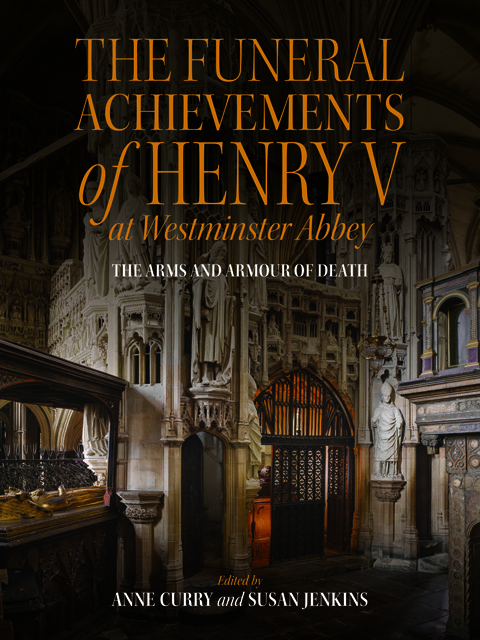Book contents
- Frontmatter
- Dedication
- Contents
- List of Illustrations
- List of Contributors
- Foreword
- Preface
- Acknowledgements
- List of Abbreviations
- 1 Introduction: Henry V and Westminster Abbey – Life, Death and Afterlife
- 2 Henry V’s Funeral Achievements in the Context of Westminster Abbey : ‘Trophies of this Warlike Prince’
- 3 The Funeral of Henry V
- 4 Henry V’s Chapel
- 5 The Funerary Helm of King Henry V : A Helm for the Joust of Peace, c. 1380–1420
- 6 A Saddle from the Funeral of Henry V
- 7 The Shield from the Funeral Achievements of Henry V
- 8 ‘Our bruisèd arms hung up for monuments’. The Sword of Henry V?
- 9 Conservation of the Funeral Achievements
- 10 Scientific Analysis: Micro-Invasive Techniques
- 11 Scientific Analysis: Non-Invasive Techniques
- Appendix: The Will of Henry V, 1421
- Index of People and Places
- Royal Armouries Research Series
11 - Scientific Analysis: Non-Invasive Techniques
Published online by Cambridge University Press: 11 January 2023
- Frontmatter
- Dedication
- Contents
- List of Illustrations
- List of Contributors
- Foreword
- Preface
- Acknowledgements
- List of Abbreviations
- 1 Introduction: Henry V and Westminster Abbey – Life, Death and Afterlife
- 2 Henry V’s Funeral Achievements in the Context of Westminster Abbey : ‘Trophies of this Warlike Prince’
- 3 The Funeral of Henry V
- 4 Henry V’s Chapel
- 5 The Funerary Helm of King Henry V : A Helm for the Joust of Peace, c. 1380–1420
- 6 A Saddle from the Funeral of Henry V
- 7 The Shield from the Funeral Achievements of Henry V
- 8 ‘Our bruisèd arms hung up for monuments’. The Sword of Henry V?
- 9 Conservation of the Funeral Achievements
- 10 Scientific Analysis: Micro-Invasive Techniques
- 11 Scientific Analysis: Non-Invasive Techniques
- Appendix: The Will of Henry V, 1421
- Index of People and Places
- Royal Armouries Research Series
Summary
In the scientific analysis of the funeral achievements of Henry V the principal non-invasive techniques used were X-rays and Medical X-ray Computerised Tomography (CT) scanning which, when allied with more traditional methods, revealed new information as well as allowing a different perspective and interpretation of these artefacts. Non-invasive techniques involve some form of imaging or analysis that does not damage or affect the artefact. There are a large number of techniques. Table 11.1 provides a summary of the most commonly used methods. Whilst there is overlap, invasive and non-invasive techniques are complementary as the first gives information about composition at a microscopic level and the second about structure and composition at a more macroscopic level. In practice, the two methods can be combined in that non-invasive imaging may identify areas suitable for invasive sampling.
The examination and understanding of artefacts is becoming increasingly multidisciplinary as the various scientific methods are combined not only with each other but also with more traditional descriptive methods including using contemporary sources to place the artefact in context. A good example would be the analysis of Viking era and early medieval swords. Traditional classification is descriptive based, for example on pommel design as in the Petersen, or Oakeshott simplified classifications, aided by measurements of blade length and geometry as in the Geibig and Oakeshott classifications. To this can be added identification of makers’ marks on a blade. Manuscripts may illustrate or describe the swords. To this descriptive analysis, non-invasive examination by X-rays and CT scans can add precise measurements of blade length and taper, the identification of marks hidden by corrosion, blade structure, particularly pattern welding, evidence of repairs and the method of pommel construction. Non-invasive XRF can identify the presence of gold or other precious metals in areas of decoration, hardness testing helps determine if the blade is made of iron or steel and invasive metallurgical analysis reveals the quality of the steel and indirectly the method of blade manufacture.
In order to produce an X-ray image a detector, formerly film but now digital, is positioned to detect X-rays passing through the object and the image results from differences in attenuation of the X-ray beam by different parts of the object. This shows as grey scale shadows in the image produced by the detector.
- Type
- Chapter
- Information
- The Funeral Achievements of Henry V at Westminster AbbeyThe Arms and Armour of Death, pp. 221 - 249Publisher: Boydell & BrewerPrint publication year: 2022



